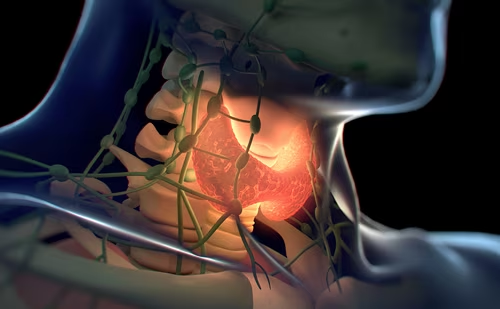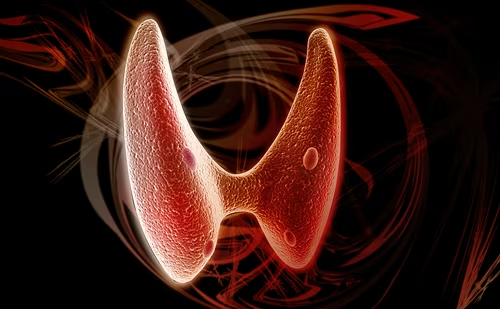Sodium-iodide Symporter (NIS)
Sodium-iodide Symporter (NIS)
Many of the biologic features of normal thyroid follicular cells have been exploited to play a role in the diagnosis and treatment of DTC. The sodium-iodide symporter (NIS), which actively pumps iodine into thyroid follicular cells, has been cloned and found in DTC, as well as other benign and malignant cells.2–4 It is an integral part of the cell membrane, which, when activated by thyrotropin (TSH), initiates the first step in thyroid hormone synthesis, resulting in iodination of tyrosine molecules on thyroglobulin (Tg). This large (670kDa) glycoprotein, which is composed of two identical subunits, is released along with thyroid hormone from normal and malignant follicular cells in response to TSH.
NIS is not only present in well-differentiated thyroid cancers, but is also found in other tissues such as the lacrimal ducts, salivary glands, gastric mucosa, and the lactating mammary gland, which accounts for some of the adverse effects of radioactive iodine (131I) therapy.4–6 NIS in these non-thyroidal tissues still provides a novel opportunity to treat other malignancies. For example, most breast cancers (80%) contain NIS that can be manipulated to facilitate 131I uptake.7,8 Conversely, NIS can be selectively downregulated in breast tissue7,8 and thyroid tissue9 and can be manipulated in vitro to enhance its effect in thyroid cancer.6,10,11 These fundamental biologic mechanisms have all been exploited in the diagnosis and treatment of thyroid cancer12 and theoretically offer promise for the treatment of breast and other types of cancer.13 Medullary Thyroid Cancer
Medullary thyroid cancer (MTC) arises from thyroid C cells that are normally found in the upper third of the thyroid lobes in and around the normal thyroid follicle. The C cells, which are derived from the embryonic neural crest, secrete calcitonin in response to an increase in serum calcium or pentagastrin.
MTC comprises only 4% of all thyroid cancers. Approximately 25% of the cases are inherited as part of the multiple endocrine neoplasia type-2 (MEN-2) syndromes. The most common is MEN-2A characterized by bilateral MTCs and pheochromocytomas, causing potentially deadly attacks of hypertension and tachyarrhythmias that are often more lethal than the MTC. Another is MEN-2B associated with bilateral MTC, mucosal neuromas mainly involving the gastrointestinal (GI) tract and eyelids, bilateral pheochromocytomas, and a marfanoid habitus and is also sometimes associated with Hirschsprung disease.14,15 A third syndrome is familial MTC (FMTC), which features only bilateral MTC without other tumors. This may be confused with MEN-2A that has late onset pheochromocytoma.16
Incidence and Mortality Rates
Thyroid cancer is an uncommon disorder; however, it is an important problem, affecting approximately the same number of people as ovarian cancer or Hodgkin’s disease does yearly. In 2000 it was diagnosed in almost 123,000 people around the world, causing an estimated 8,570 deaths.17Worldwide, it afflicts approximately one in every 100,000 people each year, but its incidence is much higher in Europe and North America.17 In the US, for example, an estimated 25,690 new thyroid cancer cases will occur in 2005, accounting for almost 2% of all the new cancers in the country, and it will cause approximately 1,490 deaths.18 While it occurs at all ages, thyroid cancer is particularly common in women, occurring at approximately three-fold the rate of that in men. Its incidence peaks in mid-life in women and approximately two decades later in men.18 This is a rare but important cause of cancer in children that affects boys and girls under the age of 10 at about the same rate, but is typically discovered at a more advanced tumor stage at the time of diagnosis than that found in adults. In fact, approximately 25%19 to 50%20 of children have lung metastases at the time thyroid cancer is diagnosed compared with fewer than 10% of adults with metastases.
Historical Changes in Incidence Rates
The incidence rates of thyroid cancer in many places worldwide have increased significantly over the past three decades.17 The rates in the US have more than doubled between 1973 and 2001, varying from approximately three to seven cases per 100,000 people (P<0.05), which was due almost exclusively to a rise in the incidence of PTC without a significant change in that of FTC.21 A study from France22 identified similar changes between 1978 and 1997 during which PTC increased by 6.2% per year in men and 8.1% per year in women. Similar observations are reported from England,23 Canada,24 and other countries,25–28 but not in every part of the world.17
The increased incidence of PTC is partly due to the exposure of children and young adults to ionizing radiation,23,29–33 but has also been attributed to iodine prophylaxis,28 to alterations in histologic diagnostic criteria of clinically unimportant thyroid neoplasia,26 and to the increasingly common discovery of asymptomatic small cancers on imaging studies, so-called ‘incidentalomas’.34 A French35 study found that the increased incidence in thyroid cancer was mainly due to PTC microcarcinomas (43% of operated cancers between 1998 and 2001), which was attributed to a significant increase in the diagnostic use of thyroid ultrasonography (3% to 85%), and fine needle aspiration biopsy (8% to 36%) in the evaluation of thyroid nodules.







